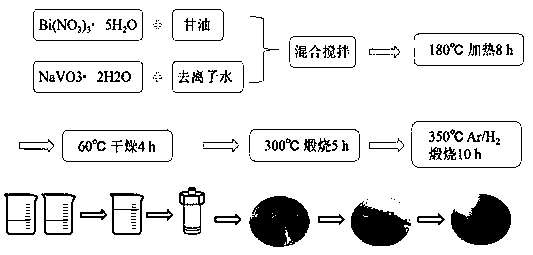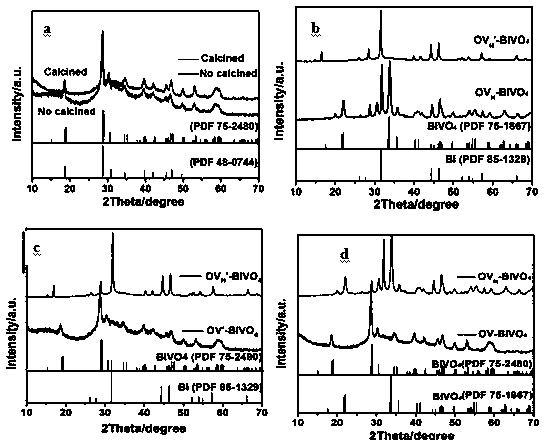H-occupied BiVO4-OVs photocatalytic material and production method and application thereof
A photocatalytic material, 3·5H2O technology, applied in the field of photocatalytic materials, can solve the problems of photocatalytic performance reduction, short carrier diffusion length, etc.
- Summary
- Abstract
- Description
- Claims
- Application Information
AI Technical Summary
Problems solved by technology
Method used
Image
Examples
Embodiment 1
[0038] (1) Add 0.4 mmol Bi(NO 3 ) 3 ·5H 2 O was dissolved in 16 ml glycerin to obtain precursor solution A;
[0039] (2) Add 0.4 mmol NaVO 3 2H 2 O was dissolved in 16 ml deionized water to obtain precursor solution B;
[0040] (3) Add solution A to solution B and stir vigorously to obtain solution C;
[0041] (4) The solution C was transferred to a polytetrafluoroethylene-lined autoclave, and the synthetic product D was obtained after maintaining at 120 °C for 6 h;
[0042] (5) The solvothermally synthesized product D was centrifuged at 10,000 rpm, washed with deionized water and ethanol, and dried at 60 °C for 4 h to obtain product E;
[0043] (6) Product E was calcined in a muffle furnace at 300 °C for 5 h to obtain product F;
[0044] (7) The product F is in Ar / H 2 In atmosphere at 350 ℃, Ar / H 2 (Vol: 95%: 5%) annealed under atmosphere for 10 h to obtain H-occupied BiVO 4 -OVs photocatalytic materials.
[0045] The resulting H occupies the BiVO 4 -OVs photocata...
Embodiment 2
[0048] (1) Add 0.4 mmol Bi(NO 3 ) 3 ·5H 2 O was dissolved in 16 ml glycerin to obtain precursor solution A;
[0049] (2) Add 0.4 mmol NaVO 3 2H 2 O was dissolved in 16 ml deionized water to obtain precursor solution B;
[0050] (3) Add solution A to solution B and stir vigorously to obtain solution C;
[0051] (4) The solution C was transferred to a polytetrafluoroethylene-lined autoclave, and the synthetic product D was obtained after maintaining at 180 °C for 8 h;
[0052](5) The solvothermally synthesized product D was centrifuged at 10,000 rpm, washed with deionized water and ethanol, and dried at 60 °C for 4 h to obtain product E;
[0053] (6) Product E was calcined in a muffle furnace at 300 °C for 5 h to obtain product F;
[0054] (7) The product F is in Ar / H 2 In atmosphere at 350 ℃, Ar / H 2 (Vol: 95%: 5%) annealed under atmosphere for 10 h to obtain H-occupied BiVO 4 -OVs photocatalytic materials.
[0055] The resulting H occupies the BiVO 4 -OVs photocatal...
Embodiment 3
[0058] (1) Add 0.4 mmol Bi(NO 3 ) 3 ·5H 2 O was dissolved in 16 ml glycerin to obtain precursor solution A;
[0059] (2) Add 0.4 mmol NaVO 3 2H 2 O was dissolved in 16 ml deionized water to obtain precursor solution B;
[0060] (3) Add solution A to solution B and stir vigorously to obtain solution C;
[0061] (4) The solution C was transferred to a polytetrafluoroethylene-lined autoclave and kept at 180 °C for 10 h to obtain the synthetic product D;
[0062] (5) The solvothermally synthesized product D was centrifuged at 10,000 rpm, washed with deionized water and ethanol, and dried at 60 °C for 4 h to obtain product E;
[0063] (6) Product E was calcined in a muffle furnace at 300 °C for 5 h to obtain product F;
[0064] (7) The product F is in Ar / H 2 In the atmosphere at 350 ℃, Ar / H 2 (Vol: 95%: 5%) annealed under atmosphere for 10 h to obtain H-occupied BiVO 4 -OVs photocatalytic materials.
[0065] The resulting H occupies the BiVO 4 -OVs photocatalytic materi...
PUM
| Property | Measurement | Unit |
|---|---|---|
| Radius size | aaaaa | aaaaa |
Abstract
Description
Claims
Application Information
 Login to View More
Login to View More - R&D
- Intellectual Property
- Life Sciences
- Materials
- Tech Scout
- Unparalleled Data Quality
- Higher Quality Content
- 60% Fewer Hallucinations
Browse by: Latest US Patents, China's latest patents, Technical Efficacy Thesaurus, Application Domain, Technology Topic, Popular Technical Reports.
© 2025 PatSnap. All rights reserved.Legal|Privacy policy|Modern Slavery Act Transparency Statement|Sitemap|About US| Contact US: help@patsnap.com



